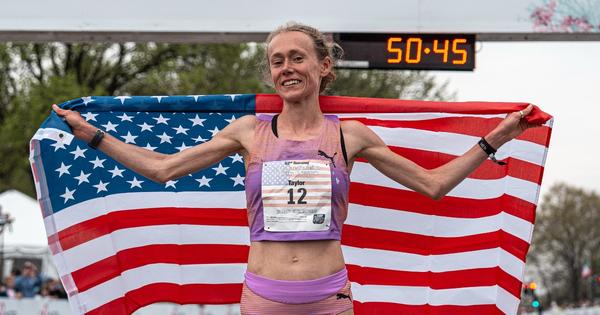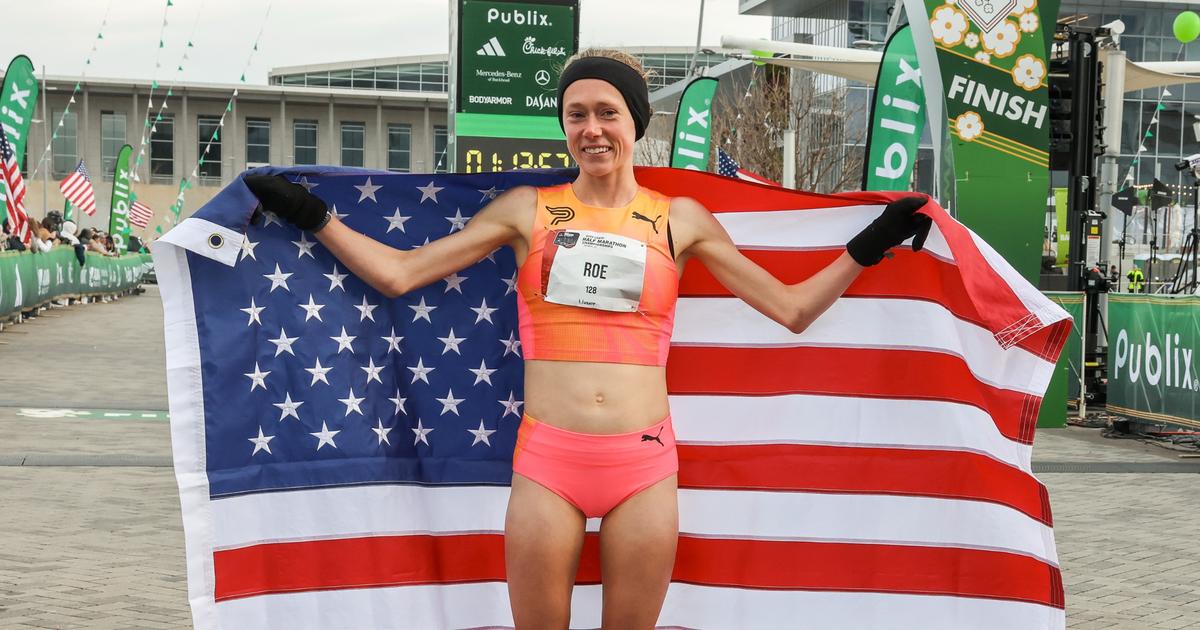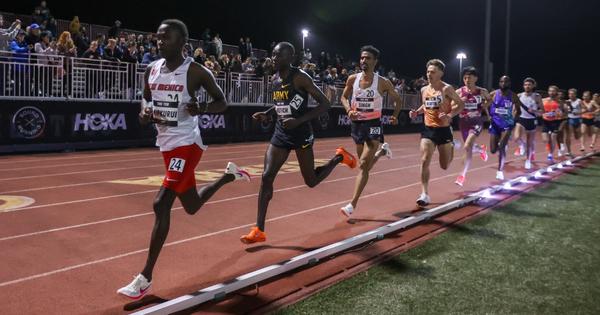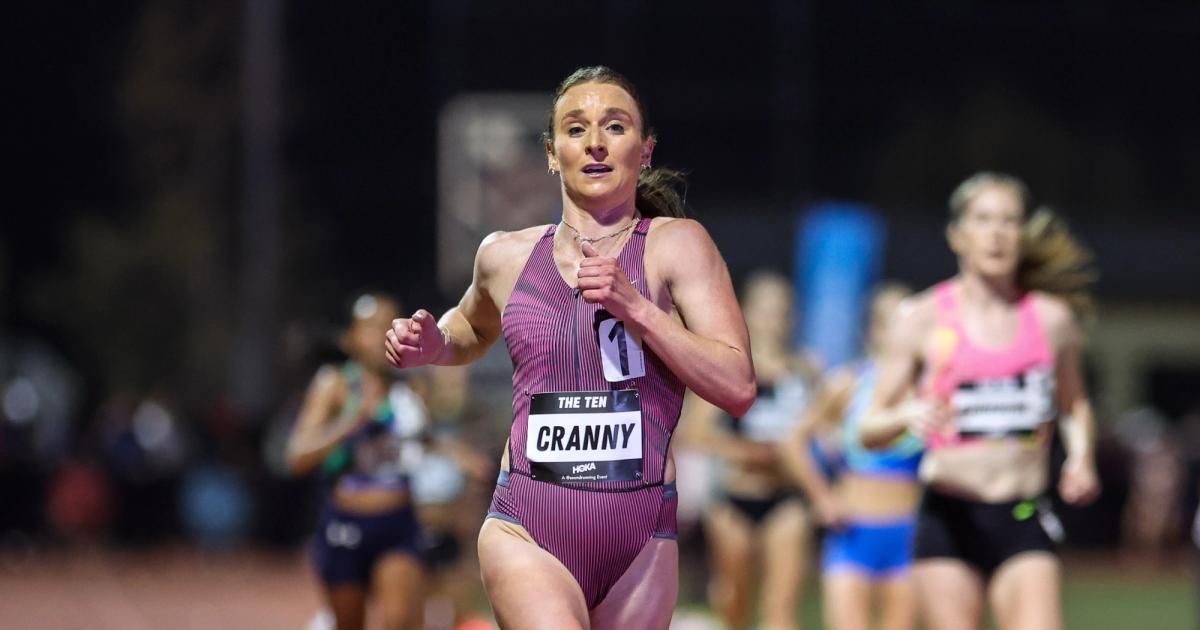By Paul Snyder
April 9, 2025
To paraphrase Rodney Dangerfield, the 10-mile distance gets no respect (it tells ya). So you could be excused if you missed the fact that three of the more exciting individual results in recent American road running history took place this past weekend in Washington, D.C. Let’s take a look at the performances that have us salivating over the future of American marathoning.
At the Cherry Blossom 10-Mile, Taylor Roe established a new world’s best in a women’s-only race, breaking the tape in 49:53, setting new American records over 10k and 15k en route as well. Taken at face value, that’s an incredible performance. Roe obviously broke the course record, winning by over a minute over a quality field. But what truly stands out from the 24-year-old Puma pro’s race was that she came through 10k two seconds faster than she ran in the 10,000m at the TEN. Roe told reporters after the race that she inadvertently wound up taking things out fast, more or less ignoring her coaches’ pacing recommendations because she felt so good, then stayed there.
That is the kind of toolbox it takes to be great in today’s marathoning landscape: the ability to go unconscious while running hard, to ignore potentially frightening inputs (like, say… PRing at 10k with almost four miles of running left), and to just hammer away. Mixing it up for World or Olympic medals—or even getting within sniffing distance of a podium finish at a World Marathon Major—requires throwing in surges and withstanding attacks alongside women who are capable of running under 2:15. If Ruth Chepngetich is going to take the pace out sub-65 and you want any chance of contending, it sure helps to have had some success when running faster than your internal governor probably thinks prudent.
We’ve discussed before the two conventional paths American athletes typically take to marathoning prowess.
The first path is the gradually sloping one, where an athlete who has hoisted up some hardware as the result of on-track heroics sticks to the oval until they feel they’ve maxed out on what they can accomplish there. Think: Galen Rupp or Sara Hall. They may dabble in shorter road races during a transitionary period where they take a crack at a 10,000m team, but for the most part, there’s a logical build-up then a clean break from track star to budding marathoner.
The second is the way of the road warrior: an accomplished but probably not national champion-caliber distance runner answers the siren song of the asphalt almost immediately after their NCAA eligibility wraps up. This archetype could conceivably continue to set personal bests and find championship success on the track—their fast twitch muscle fibers and youthfully recovering tendons still fully functional—but they also see the writing on the wall. The marathon is where they’ll ultimately butter their bread, so why wait to become acquainted?
As an NCAA 3000m champion while at Oklahoma State, Roe boasts the pedigree of the former, yet seems to be embracing the approach of the latter. Granted, she’s—as far as we know—given no indication she’ll be stepping up to the 26.2-mile distance or leaving the track behind for good anytime soon. But is there a more exciting marathoning prospect in the Young American Distance Running Rising Stars constellation out there at the moment? One could argue that a Grant Fisher or Weini Kelati debut is more intriguing, but the wild west that Roe finds herself heading towards is thrilling by its very unknown nature.
Roe has already cemented her upcoming racing schedule as being very half marathon-focused, her win at last month’s USATF Half championship securing her spot on the World Half team, still on the global calendar but now at a location and date now TBD. Here’s hoping continued success in the 10-13.1 mile range on the roads is a gateway drug to dipping one’s toes in the full marathon.
And speaking of former Oklahoma State standouts, who now train in North Carolina with Puma Elite, and who have recently won USATF titles that ensure they’ll rep Team USA at the forthcoming, mysterious World Road Running Championships… Alex Maier (24) also had a terrific performance at Cherry Blossom, running 45:15, which is a new American best.
Not to diminish Maier’s run, or just how exciting his eventual marathon debut will also undoubtedly be, but we do need to point out that he got second in the race. Charles Hicks (23) beat him by a click, going 45:14. Here’s where things get both confusing and even more intriguing, from a “let’s discuss the future of American longer distance racing” perspective. Hicks, who has historically represented Great Britain, by virtue of his Cherry Blossom victory, was crowned USATF 10 Mile champion, because he ran as a dual citizen, and is in the process of switching allegiances to be able to rep the U.S., internationally.

Charles Hicks | Photo by David Hicks
Hicks, perhaps more so than Maier or Roe, feels more likely to keep a toe in the pool of track competition, as he’s a 23-year-old NCAA champion with a 13:09.38 5000m PB currently being guided by Jerry Schumacher at the Track Club Formerly Known As Bowerman. But like many future marathoners before him, best races have tended to come on grass, winning his NCAA title on the hills of Stillwater, Oklahoma, and representing GB thrice as a junior at the European XC championships. So who knows!
Two of the most successful American marathoners in recent years, Conner Mantz and Molly Seidel, were 24 and 25 years old, respectively, when they made their debuts. And, in case you’re an alien who landed on this planet yesterday, it’s worth a reminder that their debuts were undeniable successes: a U.S. top-ten all-time performance from Mantz in Chicago, and a podium finish at the 2020 Olympic Trials for Seidel. It’s conceivable we could be a few short months away from the arrival of a generational talent to the 26.2 distance.
It’s perhaps an unhealthy way to appreciate developing talent, through the lens of marathon potential, but hey, until the 10-mile gets some respect—and we know the half has a ways to go on that front!—here we are. American distance fans have one hell of a lineup of talented, likely marathon debutants to cheer for. And until they actually do debut, we also have the ability to close our eyes and envision a whole host of 2:20 and 2:06 performances coming to fruition over the coming years.

Paul Snyder
Paul Snyder is the 2009 UIL District 26-5A boys 1600m runner-up. You can follow him on Bluesky @snuder.bsky.social.




